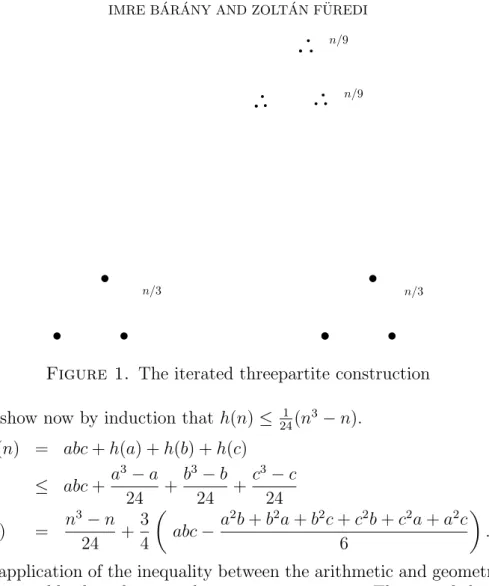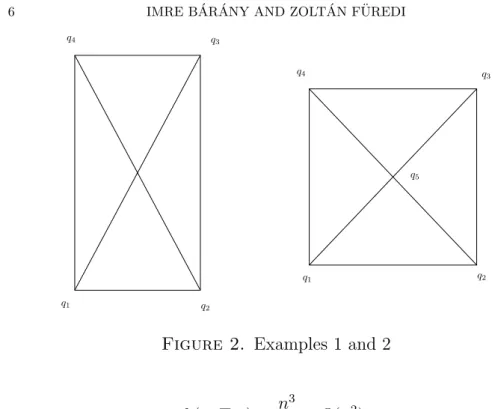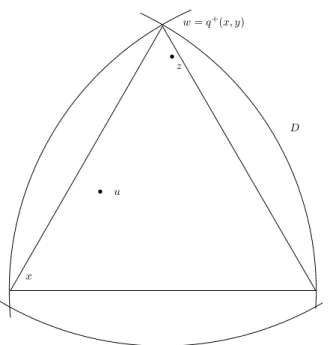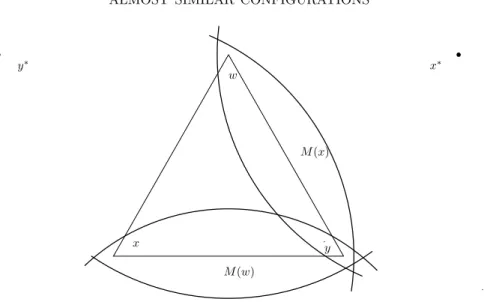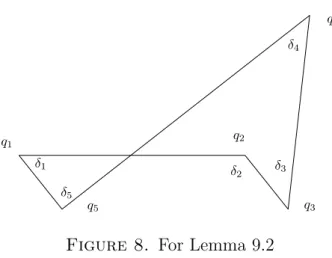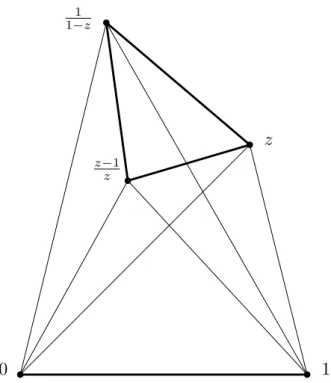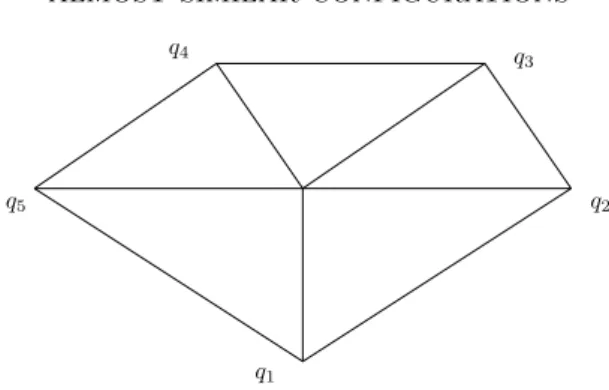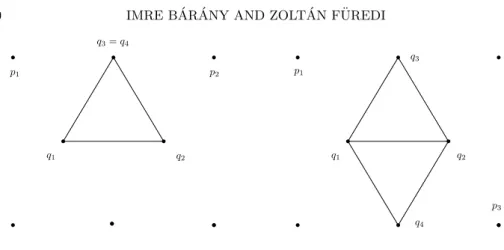IMRE B ´AR ´ANY AND ZOLT ´AN F ¨UREDI
Abstract. Let h(n) denote the maximum number of triangles with angles between 59◦ and 61◦ in anyn-element planar set. Our main result is an exact formula for h(n). We also prove h(n) = n3/24 +O(nlogn) asn→ ∞. However, there are trianglesT and n-point setsP showing that the number ofε-similar copies ofT in P can exceedn3/15 for anyε >0.
1. An exact result
Conway, Croft, Erd˝os, and Guy [4] studied the distribution of angles determined by a planar set of n points. Motivated by their questions and results we consider the following problem.
Let T be a fixed triangle with angles α, β, γ. Another triangle 4 with angles α0, β0, γ0 is called ε-similar to T if |α−α0|, |β −β0|, and
|γ −γ0|< ε. Here ε >0 is a small angle, smaller than any angle of T. Let h(n, T, ε) denote the maximal number of triangles in a planar set of n points that are ε-similar to T.
The following construction gives a lower bound on h(n, T, ε) (see Figure 1). Place the points in three groups of as equal sizes as possible, with each group very close to the vertices ofT. This only gives the lower boundn3/27−O(n). Iterating this yields a better bound: splitting each of the three groups into three further groups gives the inequality (with notation f(n) =h(n, T, ε))
f(a+b+c)≥abc+f(a) +f(b) +f(c)
wherea, b, c are the sizes of the three groups. Define the sequenceh(n) (for n = 0,1,2, . . .) as the maximum lower bound what we can have using the above iterated threepartite construction. Let h(0) =h(1) = h(2) = 0,h(3) = 1 and for all n ≥1 let
h(n) := max {abc+h(a) +h(b) +h(c) :
a+b+c=n, a, b, c≥0 integers}.
Date: May 1, 2018. Slightly revised: May 9, 2019.
2010 Mathematics Subject Classification. Primary 52C45, secondary 05D05.
Key words and phrases. similar triangles, similar configurations in the plane, extremal hypergraphs.
1
n/3 n/3 n/9
n/9
Figure 1. The iterated threepartite construction We show now by induction that h(n)≤ 241 (n3−n).
h(n) = abc+h(a) +h(b) +h(c)
≤ abc+a3−a
24 + b3−b
24 + c3 −c 24
= n3−n 24 +3
4
abc− a2b+b2a+b2c+c2b+c2a+a2c 6
. (1.1)
An application of the inequality between the arithmetic and geometric means yields that the second term is nonpositive. This proof shows also that in the inequality h(n)≤ 241(n3−n) equality holds for n ≥ 3 if and only if n is a power for 3.
Standard induction shows that for some absolute constantC > 0 for all n we have
n3
24 −Cnlogn < h(n)≤ 1
24(n3−n).
It follows that for every triangle T and for every ε >0 (1.2) h(n, T, ε)≥h(n)≥ n3
24−O(nlogn).
The constructions in Section 3 show that for some specific triangles better lower bounds hold. However, we prove in Section 8 the following theorem showing that the bound in (1.2) is very precise for almost equilateral triangles.
Theorem 1.1. Let T be the equilateral triangle. There exists an ε0 ≥ 1◦ such that for all ε∈(0, ε0) and all n we have h(n, T, ε) =h(n).
In particular, when n is a power of 3, h(n, T, ε) = 241(n3−n).
This implies that the following corollary.
Theorem 1.2. LetT be a triangle whose angles are between 60◦−ε0/2 and 60◦+ε0/2 and suppose that 0< ε < ε0/2. Thenh(n, T, ε) = h(n).
In particular, h(n, T, ε) = 241 (n3−n) if n is a power of 3.
For a general triangle T the following result holds.
Theorem 1.3. Let T be a non-degenerate triangle and ε > 0. Then the limit
h(T, ε) := lim
n→∞
h(n, T, ε) n3 exists and is at least 241 .
Moreover, for all n
(1.3) h(T, ε)(n3−n)≥h(n, T, ε)≥h(T, ε)n(n−1)(n−2).
Since h(T, ε)≤ 16 the difference between the upper and lower bound is at most n(n−1)/2.
Proof. We claim that for n≥3
(1.4) h(n, T, ε)
n 3
≥ h(n+ 1, T, ε)
n+1 3
.
This inequality implies that the limit exists. The lower bound 1/24 follows from (1.2). To prove (1.4) let X ⊂ R2 be a points set with
|X|=n+ 1 containing h(n+ 1, T, ε) trianglesε-similar toT. Consider the average density of (T, ε) triangles in the n-subsets of X
1 n+ 1
X
x∈X
h(X\ {x}, T, ε)
!
= n−2
n+ 1h(X, T, ε) = n
3
h(n+ 1, T, ε)
n+1 3
. Since the left hand side is at most h(n, T, ε) we obtain (1.4).
Denote h(n, T, ε) by f(n). Then (1.4) is exactly (14.1) (with s = 3). The iterative constructions in Section 3, more exactly (3.3) shows that the sequence f(n) satisfies condition (14.2). The proof of (1.3) is completed by Claim 14.1 given in the Appendix (Section 14).
2. Only 0.3% error for most of the triangles
The space of triangles or rather triangle shapes can be identified with triples (α, β, γ) withα, β, γ >0 andα+β+γ =π. Let S be the subset of the plane α+β+γ = π, in R3, defined by the inequalities α ≥ β ≥ γ > 0. The domain S represents every triangle by a single point. Thus we can talk about almost all triangles in the measure theory sense. Theorem 1.2 gives the exact value for h(n, T, ε0) for at least Ω(ε20) fraction ofS. It shows that (asn → ∞) at most about one quarter of the n3
triangles could be almost equilateral and this bound is the best possible.
We measure an angle α either in degrees or in radians, whatever is more convenient. We hope this is always clear from the context.
The next result uses extremal set theory, actually Tur´an theory of hypergraphs and flag algebra computations to give an upper bound for h(n, T, ε) for almost every triangleT that is only 0.5% larger than the lower bound in (1.2).
Theorem 2.1. For almost every triangle T there is an ε >0 such that h(n, T, ε)≤0.25108
n 3
(1 +o(1)).
The proof is in Sections 9 and 10. We also have a slightly better bound which is less than 0.3% larger than the lower bound in (1.2).
Theorem 2.2. For almost every triangle T there is an ε >0 such that h(n, T, ε)≤0.25072
n 3
(1 +o(1)).
The proof is computer aided and somewhat technical so we only give a sketch in Section 11.
3. Constructing many almost similar triangles The construction is recursive just as in Section 1.
LetQ={q1, . . . , qr}be a finite set in the plane, and letF(Q, T, ε) be the 3-uniform hypergraph with vertex set{1, . . . , r}andijkbe an edge of F iff the triangle qiqjqk is ε-similar to T. Then there is a positive real ρ = ρ(Q, T, ε) > 0 such that the following holds. If D1, . . . , , Dr are disks with centres at q1, . . . , qr with radii less than ρ then every triangle pipjpk with pi ∈Di, pj ∈Dj, pk ∈Dk and ijk ∈ F is ε-similar toT but all otherpipjpk triangles are not, except in the casei=j =k.
Definition 3.1 (The fusion of smaller systems). Suppose we are given a triangle T, an ε >0, and a point set Q={q1, . . . , , qr} together with further sets P1, . . . , Pr of sizes |Pi| = yi ≥ 0, n = y1 +. . .+yr. We are going to define a set P of n points, called fusion (more precisely a (T, ε)-fusion) of P1, . . . , Pr and Q as follows.
Consider appropriately small disksD1, . . . , , Dr with centres atq1, . . . , qr (i.e., their radii are less then ρ=ρ(Q, T, ε)). Place a homothetic copy Pi0 of Pi into Di. Finally, set P :=∪Pi0.
In this case we have
(3.1) h(P, T, ε) = X
1≤i≤r
h(Pi, T, ε) + X
ijk∈F
yiyjyk.
Define the multilinear polynomial p(y1, . . . , yr) of degree 3 as p(y1, . . . , yr) := X
{yiyjyk:ijk ∈ F,1≤i < j < k ≤r}.
Using (T, ε)-optimal Pi’s (i.e., h(Pi, T, ε) =h(yi, T, ε)) (3.1) implies (3.2) h(n, T, ε)≥ X
1≤i≤r
h(yi, T, ε) +p(y1, . . . , yr).
In particular, if the size of Q is a (i.e., r = a), and Q is also (T, ε)- optimal (i.e., h(Q, T, ε) = h(a, T, ε)), moreover each yi = b then (3.2) yields
(3.3) h(ab, T, ε)≥a×h(b, T, ε) +h(a, T, ε)b3.
Let us be given a triangle T, an ε > 0, an r-element planar set Q (r ≥ 3), and a vector of positive reals x = (x1, . . . , xr) such that x1 +. . .+xr = 1. Suppose further that h(Q, T, ε) > 0. We define a sequence of planar sets Pn of n points with many (T, ε) triangles recursively using the fusion. We start with P0 = ∅, |P1| = 1, and
|P2|= 2 arbitrary sets of sizes at most two.
For any givenn≥3 one can find non-negative integersy1(n), . . . , yr(n) such that
(3.4) yi(n) = bnxic or dnxie with X
yi =n.
DefinePn(Pn =Pn(Q, T, ε,x)) as the fusion ofPy1, . . . , Pyr (placed into the appropriately small disksD1, . . . , Dr with centres q1, . . . , qr). Note thatxi = 0 would mean that the pointqiis not used in the construction in which case the underlying triple systemF is different. So we suppose that xi >0 for all i and setx0 = max{xi :i= 1, . . . , r}<1.
The point setPnis not determined uniquely (becausey1(n), . . . , yr(n) are not necessarily unique). Nevertheless h(Pn, T, ε) can be estimated quite well.
Lemma 3.2. For every triangle T there is ε(T) >0 such that for all ε ∈(0, ε(T))
h(Pn, T, ε)−n3 p(x)
1−(x31+. . .+x3r)
≤ r 1−x0n2.
The proof of Lemma 3.2 will be given in Section 14 and is based on Claim 14.2 by considering the sequence g(n) :=h(Pn, T, ε).
We will, of course, choose x1, . . . , xr ≥0 to maximize the function (3.5) f(x) =f(x1, . . . , xr) = p(x)
1−(x31+. . .+x3r) under the condition that x1+. . .+xr = 1.
4. Triangles with higher densities
In this section we give several examples of trianglesT whereh(n, T, ε) is larger than in the case of almost equilateral triangles.
Example 1. T is right angled and Q = {q1, q2, q3, q4} is the set of four vertices of a rectangle such that any three vertices of P ⊂ Q form a triangle congruent to T, see Figure 2, left. The function f(x) is symmetric in its 4 variables and its maximum is taken at x1 =x2 = x3 =x4 = 1/4 where f(x) = 1/15. Consequently
q1 q2
q3
q4
q1 q2
q3
q4
q5
Figure 2. Examples 1 and 2
h(n, T, ε)≥ n3
15−O(n2), a much larger lower bound than in (1.2).
Example 2. T is an isosceles right angled triangle andQ={q1, q2, q3,q4,q5}are the four vertices and the centre of a square, see Figure 2, right. The corresponding function is symmetric again in the variables x1, x2, x3, x4 and takes its maximum when x1 = x2 = x3 = x4 = x, say. Then x5 = 1−4x and
f(x) = 4x3+ 4x2(1−4x)
1−4x3−(1−4x)3 = x−3x2 3(1−4x+ 5x2) where x ∈ [0,1/4]. The value of the maximum is 1/(6√
2 + 6) = 1/14.4852..and is reached at x= (3−√
2)/7. This gives h(n, T, ε) = n3
14.4852.. +O(n2).
Most likely this isosceles triangle gives the largest value for h(n, T, ε).
Example 3. The angles of T are 120◦,30◦,30◦ and Q={q1, q2, q3, q4} are the three vertices and the centre of an equilateral triangle, see Figure 3, left. Here f(x) is again symmetric in its first three variables, so we choose x1 =x2 =x3 =x and then x4 = 1−3x and x∈ [0,1/3]
and
f(x) = 3x2(1−3x)
1−3x3−(1−3x)3 = x(1−3x) 3−9x+ 8x2. This function is maximized at x= (9−√
24)/19 which gives h(n, T, ε)≥ n3
18.7979. . .+O(n2).
q1 q2
q4
q3
q1
q3
q2
q4
Figure 3. Examples 3 and 4
Example 4. The angles of T are α = 40.2. . .◦, 2α = 80.4. . .◦ and π −3α = 59.3. . .◦ where α is the root of the equation (sin 3α)3 = sinα(sin 2α)2. Let Q = {q1, q2, q3, q4} be a convex quadrilateral (see Figure 3, right) such that q4q1q2 and q4q2q3 are similar to T. This means that the angles at q4,∠q1q4q2 =∠q2q4q3 are equal to α, and the angles atq1 andq2, i.e., ∠q2q1q4 and∠q3q2q4 are equal to 2α. Then the triangleq3q4q1is also similar toT, so the structure of similar triangles in this Qis the same as in the previous Example 3. The same calculation leads to
h(n, T, ε)≥ n3
18.7979. . .+O(n2).
Example 5. T is the triangle with angles 90◦,60◦,30◦, Q is the set of vertices of the regular hexagon. Putting weights 1/6 on each vertex the method gives
h(n, T, ε)≥ n3
17.5 −O(n2).
This is better than what we can get from the standard iterated three- partite construction, but slightly weaker than Example 1.
5. Non-threepartite constructions
The next four examples give onlyh(n, T, ε)≥ n243+O(n2) for various T but we include them here for two reasons. First, although their order of magnitude is the same, their structure is completely different, which shows that any proof to describe the extremal families could not be too simple. Second, in cases when n is a power of 5 (or 7, resp.) these examples yield h(n, T, ε)≥ 241 (n3−n) slightly exceedingh(n).
Example 6. T has angles 108◦,36◦,36◦ and Q = {q1, q2, q3, q4, q5} are the vertices of a regular pentagon, see Figure 5, left. The function f(x) is symmetric in its five variables and setting all xi = 1/5 gives
Figure 4. Examples 5 and 8
Figure 5. Examples 6 and 7 f(x) = 1/24. We have
h(n, T, ε)≥ n3
24+O(n2).
Example 7. T has angles 72◦,72◦,36◦ and Q = {q1, q2, q3, q4, q5} are the vertices of a regular pentagon as in Example 6, see Figure 5, right. The same argument yields
h(n, T, ε)≥ n3
24+O(n2).
Example 8. The angles of T are 47π,27π, 17π and Q is the set of vertices of a regular 7-gon. The corresponding f(x) is symmetric and setting xi = 1/7 gives h(n, T, ε)≥ n243 −O(n2).
Example 9. T is arbitrary but not equilateral andQ={0,1, z,1/(1−
z),(z−1)/z} where z is a complex number such that (0,1, z) is sim- ilar to T, see Figure 9. It is well known (and easy to prove) that {1/(1 − z),0,1}, {1,(z − 1)/z,0} and {1/(1 − z),(z − 1)/z, z} are also similar to T. The function f(x) takes its maximum when x = (1/3,1/3,1/9,1/9,1/9) and this gives f(x) = 1/24. We have
h(n, T, ε)≥ n3
24+O(n2).
6. Generalizations and extensions
The definition of ε-similar triangles can be carried over to planar sets of k points, k ≥ 4. So let A ⊂ R2 be a fixed set of k points, A ={a1, . . . , ak}and δ >0. Another set B ={b1, . . . , bk} ⊂R2 and A are δ-similar if there is a λ >0 such that for alli6=j
(6.1) 1−δ ≤λ|aiaj|
|bibj| ≤1 +δ.
This is essentially the same as what we used for triangles. For any triangleT and ε >0 there exists aδ1 =δ1(T, ε) such that a triangle T0 which isδ-similar toT according to (6.1) withδ < δ1is alsoε-similar to T (in the way we use this in all other sections). On the other hand, for everyδ > 0 there exists anε1 =ε1(T, δ) such that a triangleT0 which is ε-similar to T, ε < ε1, is alsoδ-similar to T according to (6.1). Define H(n, A, δ) as the maximal number of δ-similar copies of A present in an n-element set in R2. Placing k groups of points, each of size n/k, very close to the points of A and iteration shows that for all A and δ > 0
(6.2) H(n, A, δ)≥ nk
kk−k +O(nk−1).
Claim 14.1 applies here as well and shows that the limit
(6.3) lim
n→∞
H(n, A, δ)
n k
exists and the inequality above shows that it is at leastk!/(kk−k)>0.
The case of truly similar copies, that is when δ = 0, is different.
Then H(n, A,0) ≤ 2n(n − 1). Elekes and Erd˝os [5] showed that H(n, A,0)≥cn2−o(1) for every setA, andH(n, T,0)≥n2/18 for every triangleT. Laczkovich and Ruzsa [9] proved the remarkable result that H(n, A,0) = Ω(n2) if and only if the cross ratio of any four elements of A is algebraic. Here A is considered as a k-element set of complex numbers and the cross ratio of four complex numbers z1, z2, z3, z4 is
(z1−z3)/(z3−z2) (z1−z4)/(z4−z2). See more in [1].
The same question comes up in higher dimensions as well. Elekes and Erd˝os [5] and Pach [11] proved that for everyd-dimensional simplex4d
n(d+1)/d−o(1) ≤H(n,4d,0) =O(n(d+1)/d).
For results on equilateral triangles in Rd, d≤5 see [2].
7. Optimal configurations
Let T be any given triangle and assume ε >0 is small. A point set P ∈ R2 with |P| =n gives rise to a 3-uniform hypergraph H(P, T, ε):
its vertex set is P and xyz ∈ H if the triangle with vertices x, y, z ∈P is ε-similar to T. So we have
h(n, T, ε)≥ |H(P, T, ε)|
and P is called optimal (or optimal for T) if here equality holds. We write deg(x) resp. deg(x, y) for thedegreeof xandcodegree ofxy, that is deg(x) resp. deg(x, y) is the number of triples inH containingxand both x and y.
We write B(x, r) for the Euclidean ball centred at x and having radius r. There is a small η0 = η0(P) > 0 (depending only on P) such that for any η∈(0, η0) the following holds. If xyz ∈ H, then the triangle with verticesx0, y0, z0 isε-similar toT for anyx0 ∈B(x, η), y0 ∈ B(y, η), z0 ∈B(z, η).
Assume next that x, y ∈ P, deg(x, y) = 0 and deg(x) ≥ deg(y), and let x0 ∈ B(x, η) an arbitrary point, distinct from x. Define P0 = P ∪ {x0} \ {y}.
Lemma 7.1. Under these conditions, |H(P0, T, ε)| ≥ |H(P, T, ε)|. If deg(x)>deg(y) then |H(P0, T, ε)|>|H(P, T, ε)|.
Theproofis simple: The triples inHnot containingyremain triples inH0. Write deg0(.) for the degrees inH0 =H(P0, T, ε). Sincexuv ∈ H (here u, v are distinct from y) implies x0uv ∈ H0 and xuv ∈ H0, we have deg0(x0) ≥ deg(x) and deg0(x) = deg(x) ≥ deg(y). So indeed,
|H0| ≥ |H|, and the inequality is strict if deg(x)>deg(y).
Assume next that deg(x, y) = deg(x, z) = 0. By the previous claim we can replace both yand z byx0, x00 ∈B(x, η) so that with P00 =P∪ {x0, x00} \ {y, z}the new hypergraph H00 satisfies|H00| ≥ |H|. Actually, x0 and x00 can be chosen so that the triangle xx0x00 is ε-similar to T so
|H00|>|H|. We obtained the following:
Corollary 7.2. If the planar setP ofnpoints is optimal, thendeg(x) = deg(y) for every x, y ∈P with deg(x, y) = 0. Moreover, if deg(x, y) = deg(u, v) = 0, then {x, y} and {u, v} are disjoint or they coincide.
We are going to fix an optimal planar setP ofnpoints such that the diameter of P is one, and all parirs of points x, y ∈P with deg(x, y) = 0 are very close to each other. This is accomplished with the next technical lemma.
Lemma 7.3. There is an optimal planar set P of n points and an η ∈ (0,10−3) such that the diameter of P has length one, the points u, v ∈P with deg(u, v) = 0 satisfy |uv|< η and every disk of radius η contains at most two points from P.
Proof. Start with an optimal planar set Q of n points and let x0, y0 ∈ Q be the pair with maximal distance |x0y0| among all pairs u, v with deg(u, v) ≥ 1. As a homothety does not change ε-similarity we assume that |x0y0|= 1.
Next choose η > 0 smaller than η0(P), and smaller than 10−3, and smaller than one tenth the minimal distance among pairs in Q. Apply Lemma 7.1 to every pair u, v ∈ P with deg(u, v) = 0. Such pairs are disjoint and deg(u) = deg(v) by Corollary 7.2. So we can replace v by u0 ∈B(u, η) or u by v0 ∈ B(v, η). The choice between u0 and v0 is arbitrary except when x0 ory0 is present in the pair. Then we keepx0 (resp. y0) and replace the other element of the pair by x00 ∈ B(x0, η) (and byy00). We get a new setQ0 ofnpoints still maximizingh(n, T, ε).
The diameter of Q0 is between 1 and 1 + 2η. Apply another homothety so that the diameter of the new set P of npoints obtained from Q0 has diameter one. Then P satisfies the requirements.
8. Proof of Theorem 1.1
In this section all angles are measured in radians and we fixε= 1/50.
We need some definitions. We call a triangle ε-equilateral if it is ε- similar to the equilateral triangle. For distinctx, y ∈R2 defineq+(x, y) (resp. q−(x, y)) as the point in R2 obtained by rotating y about x by π/3 anti-clockwise (resp. clockwise), see Figure 6 for q+(x, y). Then, for distinct points u, v, the points u, v, q±(u, v) are the vertices of an equilateral triangle. Assume uvw is an ε-equilateral triangle. Then w is close to either q+(u, v) or to q−(u, v). More formally, a simple computation using ε= 1/50 shows that
(8.1) w∈B(q+(u, v),1.2ε|uv|)∪B(q−(u, v),1.2ε|uv|).
We begin now the proof of Theorem 1.1. Fix a maximizer set P of n points, P ⊂ R2 as in Lemma 7.3. The diameter of P is realized on points x, y ∈P so|xy|= 1 and deg(x, y)≥1 since pairsu, v ∈P with deg(u, v) = 0 are at distance less than η < 10−3. So there is z ∈ P with xyz ∈ H. Fix such a z and set s = 1.2ε = 0.024. According to (8.1), z is close to eitherq+(x, y) or to q−(x, y). We may assume that it is close to w=q+(x, y) and soz ∈B(w, s) implying that
P ⊂ B(x,1)∩B(y,1)∩B(z,1)
⊂ B(x,1)∩B(y,1)∩B(w,1 +s) := D because B(z,1)⊂B(w,1 +s).
Here D is a convex set, see Figure 6. Rotating D about x by angle π/3 anti-clockwise resp. clockwise we obtain the setsD+(x) andD−(x).
The setsD+(y), D+(w) andD−(y), D−(w) are defined analogously. Set further x∗ =q+(w, y), y∗ = q+(x, w) and w∗ =q+(y, x) (see Figure 7)
x y z
u
D w=q+(x, y)
Figure 6. The domainD, z, and w=q+(x, y) and define
M(x) = B(x,1 + 2s)∩B(x∗,1 + 2s), M(y) = B(y,1 + 2s)∩B(y∗,1 + 2s), M(w) = B(w,1 + 2s)∩B(w∗,1 + 2s).
Set further N(w) =M(x)∩M(y), N(y) =M(x)∩M(w), and N(x) = M(w)∩M(y).
Lemma 8.1. P ⊂N(x)∪N(y)∪N(w).
Proof. Assume u∈ P. If deg(x, u) = 0, then u ∈ B(x, η)⊂ N(x).
The same argument applies when deg(y, u) = 0. If deg(z, u) = 0, then u∈B(z, η) andB(z, η)⊂N(w).
Thus we assume deg(x, u),deg(y, u),deg(z, u)≥1. Here deg(x, u)≥ 1 means there is v ∈ P with xyv ∈ H implying by (8.1) that v ∈ B(q+(x, u), s)∪B(q−(x, u), s). In other words, rotating u about x by angle π/3 or −π/3 we arrive at a point at distance at most s from v ∈P ⊂D. Going backwards, that is, rotating D about xbyπ/3 and
−π/3 we obtain the setsD+(x) and D−(x) such that u ∈ [(D∩D+(x))∪(D∩D−(x))] +B(0, s)
= [(D∩D+(x)) +B(0, s)]∪[(D∩D−(x)) +B(0, s)],
where addition is the usual Minkowski addition. HereD+(x) = B(x,1)∩
B(y,1 +s)∩B(w∗,1), and then
(D∩D+(x)) +B(0, s)⊂B(w,1 + 2s)∩B(w∗,1 +s)⊂M(w).
x y
y∗ w x∗
M(x)
M(w)
Figure 7. The sets M(x) andM(w) and their intersection One proves similarly that
(D∩D−(x)) +B(0, s)⊂B(y,1 +s)∩B(y∗,1 + 2s)⊂M(y), implying that u ∈ M(y)∪M(w). The same way u ∈ M(w)∪M(x) follows from deg(y, u)≥1, see Figure 7.
Finally, deg(z, u)≥1 implies that there is t∈ P such that zut ∈ H and then by (8.1)
t ∈B(q+(z, u), s)∪B(q−(z, u), s)⊂B(q+(w, u),2s)∪B(q−(w, u),2s) where the last containment follows from q±(z, u) ∈ B(q±(w, u), s).
Then
u∈[(D∩D+(w)) +B(0,2s)]∪[(D∩D−(w)) +B(0,2s)]
and D+(w) = B(y,1)∩B(w,1 +s)∩B(x∗,1). This shows that (D∩D+(w)) +B(0,2s)⊂B(x,1 + 2s)∩B(x∗,1 + 2s) =M(x).
One proves the same way that (D ∩ D−(w)) + B(0, s) ⊂ M(y), so u∈M(x)∪M(y).
We have shown so far that
(8.2) u∈[M(x)∪M(y)]∩[M(y)∪M(w)]∩[M(w)∪M(x)], not quite what we wanted but we are not far. It is easy to check that relation (8.2) holds if and only if u is contained in at least two of the sets M(x), M(y), M(w). Observe now that M(x)∩M(y)∩M(w) = ∅.
Indeed, if these three sets had a point in common, then their union would cover the triangle xyw because the edges xy, yw, wx resp. are contained in M(w), M(x), and M(y). But none of the sets contains the centre of the triangle xyw.
This implies that (8.2) holds if and only if u is contained either M(x)∩M(y) or inM(y)∩M(w) or inM(w)∩M(x).
Now we return to the proof of Theorem 1.1. SupposeP has a points in N(x), bpoints in N(y) andcinN(w). By the lemman =a+b+c.
Write f(n) = h(n, T, ε). We are going to show that f(n)≤h(n).
We prove next that no triangle in H has two points in N(w) and one in N(y). This is quite simple: assume x1y1z1 ∈ H is a triple with x1, y1 ∈N(w) and in z1 ∈N(y). A simple and generous computation shows that the diameter of N(w) is smaller than 5s +√
2s = 0.32.
On the other hand, the distance between N(w) andN(y) is 1−√ 6s= 0.346.... So the ratio of the lengths of one edge (x1z1 ory1z1) to another edge (namely x1y1) is at least 0.346.../0.32>1.08. On the other hand, the ratio of the length of any two edges in an ε-equilateral triangle is at most sin(π/3 +ε)/sin(π/3− ε) = 1.0233.. < 1.03 (where ε = 1/50). Consequently x1y1z1 is not an ε-equilateral triangle, contrary to x1y1z1 ∈ H.
It follows that there are two kinds of triples in H: either one vertex in each of N(x),N(y), and N(w) or all three vertices are in one of the sets N(x),N(y), and N(w).
The number of triangles with one vertex in each of N(x),N(y), and N(w) is abc. The number of triangles with all vertices in N(x), N(y), resp. N(w) is f(a), f(b), andf(c). Thus
f(n)≤abc+f(a) +f(b) +f(c)
and the argument (1.1) finishes the proof.
9. Tur´an problems for hypergraphs
Tur´an’s theory of extremal graphs and hypergraphs has several ap- plications in geometry (see, e.g. [10]) and elsewhere [6]. Here we explain what we need for Theorem 2.1, for the case of 3-uniform hypergraphs.
LetL be a finite family of 3-uniform hypergraphs, the so-calledforbid- den hypergraphs. Tur´an’s problem is to determine the maximal number of edges that a 3-uniform hypergraph H on n vertices can have if it does not contain any member of L as a subhypergraph. This maximal number is usually denoted by ex(n,L).
Define K4− = {124,134,234} which is the complete 3-uniform hy- pergraph on four vertices minus one edge, and C5 = {123, 234, 345, 451, 512} which is the 5-cycle, and let L = {K4−, C5}. We need the following result of Falgas-Ravry and Vaughan [7]:
(9.1) (0.25 +o(1)) n
3
≤ex(n,{K4−, C5})≤0.251073 n
3
. The upper bound part of this result will be used in the proof of Theo- rem 2.1 (weaker version). First some preparation is needed.
Given a triangle T with angles α, β, γ an equation of the form n1α+n2β+n3γ+n4π= 0
is called a non-trivial linear equationof T if the vector (n1, n2, n3, n4) is linearly independent from (1,1,1,−1), their coordinates are integers, and all are at most 5 in absolute value. Note that the equation α+ β+γ−π = 0 is satisfied by every triangle.
Here we extend the definition of the hypergraph F(Q, T) used in Section 3: given a finite multiset Q={q1, . . . , qr} ⊂R2 and a triangle T, the vertex set of F(Q, T) is{1, . . . , r}andijk is an edge ofF(Q, T) iff either qiqjqk is similar to T or qi = qj = qk. The multiset Q is trivialif all of its points coincide. Otherwise we say thatQ realizesthe hypergraph F and that F can be realized by T.
Lemma 9.1. Assume Q = {q1, q2, q3, q4} is a nontrivial multiset and F(Q, T) contains a copy of K4−. Then the angles of T satisfy a non- trivial linear equation.
Lemma 9.2. Assume Q = {q1, . . . , q5} is a nontrivial multiset and F(Q, T) contains a copy of C5. Then the angles of T satisfy a non- trivial linear equation.
The proof of these lemmas are postponed into the next Section.
Proof of Theorem 2.1. Assume T is a triangle whose angles do not satisfy any non-trivial linear equation. Then there is an ε(T)>0 such that no triangle which is ε-similar to T satisfies any non-trivial linear equation. The reason is that, in the space of triangle shapes, S, T is at positive distance from the closed set defined by the finitely many non-trivial linear equations.
This implies that, given a planar set P of n points, the hypergraph H(P, T, ε) contains no copy of K4− and no copy of C5, provided ε <
ε(T).
Conjecture 9.3 (Falgas-Ravry and Vaughan, Conjecture 8 in [7]).
limn→∞ex(n,{K4−, C5}) n3−1
= 1/4.
This conjecture (if true) implies that h(n, T, ε) = (1 +o(1))n3/24 for all triangles T whose angles do not satisfy any non-trivial linear equation and for small enough 0< ε < ε(T).
10. Proof of the two lemmas, realizations of K4− and C5 In both lemmas the triangles in F(Q, T) cover all pairs of Q. So if Q contains any point with multiplicity at least 2 then it contains a triangle of size 0, and one can easily see that all other triangles are of size 0, i.e., Q is a trivial multiset. From now on, we may assume that Q is a proper set and T has angles α, β, and γ.
Proof of Lemma 9.1. Four distinct points q1, . . . , q4 are given such that the three triangles of the form qiqjq4, 1≤i < j≤3, are similar to
q1 q2
q3 q4
q5
δ2 δ3
δ4
δ5
δ1
Figure 8. For Lemma 9.2
T. First, consider the case when q4 lies on the boundary of the convex hull of Q. Then (with a possible relabeling of q1, q2, andq3) we obtain
∠q1q4q2 +∠q2q4q3 =∠q1q4q3.
Here all the three angles belong to {α, β, γ} so we obtain either an equation likeα+β =γ (implyingγ =π/2) or an equation of the form 2β =α. In each case we got a non-trivial linear equation.
Actually, one can show that in this caseT is either right angled or the unique triangleT defined in Example 4 whose angles are approximately 40.2◦, 80.4◦, and 59.3◦.
From now on, we may suppose that q4 is in the interior of conv Q.
Then convQ is a triangle with vertices q1, q2, and q3 and we have
∠q1q4q2+∠q2q4q3+∠q3q4q1 = 2π.
Here all the three angles belong to {α, β, γ} so all three must be the same and equal to α, say (otherwise we get a contradiction like α+ β +γ = 2π or 2π > 2α+β = 2π). Then 3α = 2π is a non-trivial linear equation. It is easy to see in this case that the angles of T are
2π/3, π/6, π/6, the case in Example 3.
Proof of Lemma 9.2. Let δi denote the angle qi−1qiqi+1, subscripts taken mod 5. Here δi ∈ {α, β, γ} because qi−1qiqi+1 is an angle of a triangle similar to T. The polygonal path q1q2q3q4q5q1 is closed, see Figure 8, implying that
(10.1) ±δ1±δ2±δ3±δ4±δ5 ≡0 mod 2π,
where we have to select the appropriate signs according to the polygonal path. We claim that each of the 25 choices of signs lead to a non-trivial linear equation.
Denote byn1 the coefficient ofαin (10.1), andn2 andn3 are defined analogously. It follows that
(10.2) n1α+n2β+n3γ =n4π,
0 1 z
1 1−z
z−1 z
Figure 9. {123,124,125,345}can be realized by all triangles.
where each ni is an integer, |n1|+|n2|+|n3| ≤5, |n4| ≤ 4. Moreover
|n1|+|n2|+|n3| is odd and |n4|is even, so the vector (n1, n2, n3,−n4)
is linearly independent from (1,1,1,−1).
11. The two ingredients of the proof of Theorem 2.2 To prove the stronger version of Theorem 2.1 further forbidden hy- pergraphs are needed. Let L consist of the following 9 hypergraphs:
(1) K4− ={123,124,134}
(2) C5− ={123,124,135,245}, a cycle C5 minus an edge, (3) C5+ ={126,236,346,456,516}, called 5-wheel,
(4) L2 ={123,124,125,136,456}
(5) L3 ={123,124,135,256,346}
(6) L4 ={123,124,156,256,345}
(7) L5 ={123,124,145,346,356}
(8) L6 ={123,124,145,346,356}
(9) P7−={123,145,167,246,257,347}, the set of lines on the Fano plane with one line removed.
For the proof of Theorem 2.1 we need the following fact.
Claim 11.1. limn→∞ex(n,L) n3−1
<0.25072.
The proof of this claim is based on the flag-algebra method due to Razborov [12]. It requires computations by a computer: we used the
“Flagmatic” package developed by Falgas-Ravry and Vaughan [7, 13]
(thanks to them). To get an upper bound we needed the following
command, where the nine lines with ’forbid’ encode the nine forbidden members of L.
flagmatic --r 3 --n 7 --dir output --forbid-k4-
--forbid 5:123124135245 --forbid 6:123124135146156 --forbid 6:123124125136456 --forbid 6:123124135256346 --forbid 6:123124156256345 --forbid 6:123124135146356 --forbid 6:123124145346356
--forbid 7:123145167246257347 --verbose
We asked our friends Manfred Scheucher (Graz, Austria) and John Talbot (Univ. College, London, UK) (thanks to both of them as well) who had Flagmatics implemented on their laptops to type in the above command. In both cases, independently, the computers after 20 min- utes and about 80 iterations returned the upper bound 0.25072.
The other tool we need to complete the proof of Theorem 2.1 is to show that, for almost every triangle shapeT, there is anε(T)>0 such that for every finite set P ⊂ R2 the hypergraph H(P, T, ε) contains no hypergraph from L. For this purpose define, for every L ∈ L, the set S(L) of triangle shapes 4 that can realize L ∈ L as F(Q,4) with a suitable (non-trivial multi)set Q ⊂ R2 of the same size as the vertex set of L. Note that there are many hypergraphs, e.g., F3,2 :=
{123,124,125,345}, which can be realized by all triangles, esp. when we allow multiple vertices (see Figure 9). So S(F3,2) = S.
We remark that every triple system on at most 6 vertices which is not a subfamily of the standard iterated threepartite construction contains a member (1)–(8) from our list L.
Lemma 11.2. For every L ∈ L and for almost every triangle shape T there is an ε(T) > 0 such that the distance between T and S(L) is larger than ε(T).
This is in fact 9 lemmas, one for each L∈ L. Out of them the case L =K4− is just Lemma 9.1. Also the caseL =C5+ can be handled as Lemma 9.2. Indeed, if F(Q,4) realizesC5+ with the central vertex q6, and the triangles are q1q2q6,q2q3q6,q3q4q6,q4q5q6, andq5q1q6, then with notation δi =∠qiq6qi+1(i= 1, . . . ,5) we have±δ1±δ2±δ3±δ4±δ5 ≡0 mod 2π. This is the same as (10.1), leading to a non-trivial linear equation.
12. Algebraic conditions for triangle realizations This section is the continuation of the proof of Lemma 11.2, actually only a sketch.
q1
q2
q3
q4
q5
Figure 10. A realization of the 5-wheel, C5+.
For the other L ∈ L linear equations do not suffice. We need non- trivial polynomial equations. We explain the proof method in detail only for C5−. The other cases are similar and technical, and we leave them to the interested reader.
It is more convenient to work with a different representation of trian- gle shapes, namely with complex numbers. Given a triangleT its shape is identified with a complex number z ∈ C\R such that the triangle with vertices 0,1, z is similar to T. In fact there are twelve complex numbers w such that the triangle 0, 1, w is similar to T (unless T is isosceles). The set of these twelve points is T(z) and, as one can check easily,
T(z) ={z,1−z,1/z,1−1/z,1/(1−z), z/(z−1) and their conjugates}.
Figure 9 shows some of these points. It follows that if a, b ∈ C are distinct, and w∈ T(z) then a, b and v =w(b−a) +a form a triangle similar toT. It is also true that ifa, b, uis a triangle similar toT, then u must be obtained in this way, so it is a ratio of two linear functions of z, or its conjugate,z. The coefficients of the linear functions depend ona and b. Setz =x+iy. Hence the real and imaginary part ofuare a ratio of two quadratic polynomials in variables xand y.
Assume next that F(Q, T) is C5− and Q = {q1, . . . , q5}. If q1 = q2, then the size of the triangle q1q2q3 is 0. Eventually we obtain that Q should be a trivial multiset. So we may suppose that q1 6= q2. Then (after a proper affine transformation) we may suppose that q1 = 0 and q2 = 1.
As q1q2q3 is similar toT,q3 is one of those twelve points that can be expressed as the ratio of two linear functions in z or inz. Again, since q1q3q5 is similar to T, q5 can be expressed as a ratio of two quadratic functions in z or inz. Consequently, the real and imaginary part of q5 can be written as the ratio of two degree four polynomials in variables x, y. Note that typically there are many, but of course finitely many, such points. An upper bound is 122.
q1 q2 q1 q2
q3
q4
q3=q4
p1 p2 p1
p3
Figure 11. The two cases in Lemma 12.1
Analogously, via the chain of triangles q1q2q4, q2q4q5, the real and imaginary parts of q5 are equal to the ratio of two (degree four) poly- nomials in x, y, again in at most 122 ways. So the coordinates of q5 are computed in two different ways. Each one of the at most 122×122 possibilities gives two (degree 8) polynomial equations (with integer coefficients) for the pair x, y. Such a pair of equations is non-trivial if it is not the identity.
The target is then to show that for each of the 124 = 20,736 such pairs of equations there is a z not satisfying it. Then, by continuity, there is a small neighborhood of z not satisfying the equations, so its solution set could not be full dimensional, it is an algebraic curve on C. The union of these 124 curves is exactly S(C5−). Hence it is a small closed set and almost allT avoids it. This part of the proof is geometric and is the content of the next lemma.
Lemma 12.1. Assume Q = {q1, q2, q3, q4, q5} ⊂ R2 is a non-trivial multiset and T is the equilateral triangle. Then F(Q, T) does not con- tain C5−.
Proof. Recall that ifq1 and q2 coincide then all the points in Q co- incide. So q1 6=q2 and q1q2q3 and q1q2q4 are non-degenerate equilateral triangles. So either q3 = q4 or they are on opposite side of the line through q1, q2. On Figure 11 these two cases are shown, the points are from a triangular grid, and we use the notation there.
Observe first that in both casesq5is eitherp1orq2 because 135∈C5−. When q3 =q4,q5 coincides with eitherq1 orp2 because 245∈C5−. This is a contradiction since the sets {p1, q2} and {q1, p2} are disjoint.
When q3 and q4 are distinct,q5 must coincide with either q1 orp3, a contradiction again because the sets {p1, q2} and {q1, p3} are disjoint.
13. More problems
Remark. Theorem 1.1 was proved withε= 0.02 that is for triangles whose angles are between 58.9◦ and 61.1◦. The computations were
generous and the statement of the theorem must be valid for a larger interval of angles, for instance between 56◦ and 64◦.
The following Tur´an type conjecture (a weakening of Conjecture 9.3) would solve our problem asymptotically for all but a few triangles.
Conjecture 13.1. limn→∞ex(n,{K4−, C5−}) n3−1
= 1/4.
Acknowledgements. This work is partly supported by the Na- tional Science Foundation under Grant No. DMS-1440140 while the first author was in residence at the Mathematical Sciences Research Institute in Berkeley, California, during the Fall 2017 semester. The first author was also supported by Hungarian National Research, De- velopment and Innovation Office, Grants no. K111827 and K116769, and this support is acknowledged. Research of the second author was partially supported by the National Research, Development and In- novation Office Grant no. K116769, and by the Simons Foundation Collaboration Grant #317487.
We thank again Falgas-Ravry and Vaughan [7] and Manfred Scheucher and by John Talbot for computer help.
14. Appendix about recurrence sequences
Suppose that we have an integer s≥2 and a non-negative sequence f(0), f(1), . . . such that f(0) = · · · = f(s −1) = 0 and f(s) = 1.
Suppose that for all integers n≥s this sequence satisfies
(14.1) f(n)
n s
≥ f(n+ 1)
n+1 s
. Then we have the limit γ, 1≥γ ≥0, defined as
n→∞lim f(n)/
n s
=:γ.
Suppose that for all positive integers a, b this sequence satisfies (14.2) f(ab)≥af(b) +f(a)bs.
Claim 14.1. The inequalities (14.1) and (14.2) imply that for all n γns−n
s! ≥f(n)≥γ n
s
.
Note that the difference between the upper and lower bound is at most s2
ns−1/s!.
Proof. The existence of the limit γ and the lower bound follow from (14.1). To prove the upper bound apply (14.2) with (a, b) = (n, n).
We get f(n2)≥f(n)(n+ns). Apply again with (a, b) = (n2, n) we get f(n3)≥n2f(n) +f(n2)ns≥f(n)(n2+ns+1+n2s).
Repeating this up to (a, b) = (nt−1, n) we get f(nt)≥f(n)nt−1 n0+ns−1+· · ·+n(s−1)(t−1)
=f(n)nt n
n(s−1)t−1 ns−1 −1 . Divide both sides by nst and take the limits of both as t → ∞.
Then (14.1) yields
γ
s! ≥ f(n) ns−n
as stated.
Next, we consider another recurrence needed for Lemma 3.2. Recall the setting: F is a (non-empty) 3-uniform hypergraph on r vertices (r ≥3) such that∪F = [r], the multilinear polynomial p(y1, . . . , yr) of degree 3 is defined by
p(y1, . . . , yr) := X
{yiyjyk:ijk ∈ F,1≤i < j < k ≤r}.
Suppose a vector x= (x1, . . . , xr) is given withP
xi = 1 and 0< xi <
1 for each xi. Set x0 = maxxi.
For any given n≥3 a partitiony1(n) +· · ·+yr(n) =nis given where y1(n), . . . , yr(n) are non-negative integers such that
yi(n) = bnxic ordnxie.
Suppose that the (non-negative) sequenceg(0), g(1), . . . satisfiesg(0) = g(1) =g(2) = 0, and in case ofn≥3 the following recurrence
g(n) = X
1≤i≤r
g(yi)
!
+p(y1, . . . , yr) Claim 14.2. For alln
g(n)− p(x) 1−P
x3in3
< r 1−x0n2,
Proof. We use induction on n. First, it is clear that g(n)≤ n3 for alln. This implies that Claim 14.2 holds for alln ≤6r/(1−x0). Write yi =xin+εi where |εi|<1. The following fact is easy to check.
Fact 14.3. 0< p(x)/(1−P
ix3i)<1/6.
Indeed, 6p(x1, . . . , xr)<(x1+· · ·+xr)3−P
x3i = 1−P
x3i. g(n)− p(x)
1−P
x3in3 = X
i
g(yi) +p(y1, . . . , yr)− p(x) 1−P
x3in3
= X
i
g(yi)− p(x) 1−P
x3iyi3 (14.3)
+ p(x) 1−P
x3i X
i
y3i −x3in3 (14.4)
+ p(y1, . . . , yr)−p(x)n3 . (14.5)
Concerning (14.3) we use the induction hypothesis
X
i
g(yi)− p(x) 1−P
x3iy3i
≤ r 1−x0
X
i
yi2
= r
1−x0
n2X
x2i +X
εi(yi+nxi)
< r 1−x0
n2x0+X
(yi+nxi)
= r
1−x0(n2x0+ 2n)≤
rx0
1−x0 +1 3
n2. In the last inequality we used that n >6r/(1−x0).
Concerning (14.4) we have
|y3i −x3in3|=|εi||(yi2+yinxi+n2x2i)| ≤yi2+yinxi+n2x2i. This gives
X
i
y3i −x3in3
≤X
i
y2i +yinxi+n2x2i
<(X
yi)2+ (X
yi)(X
nxi) + (X
nxi)2 = 3n2. Applying Fact 14.3 we obtain that the absolute value of (14.4) is at most n2/2.
Concerning (14.5) we have
|yiyjyk−n3xixjxk|=
|n2(xixjεk+xixkεj+xjxkεi) +n(xiεjεk+xjεiεk+xkεiεj) +εiεjεk|
< n2(xixj +xixk+xjxk) +n(xi+xj+xk) + 1.
This gives X
{i,j,k}∈F
|yiyjyk−n3xixjxk|< n2X
xixj +nX
xi+X 1
< n2(r−2)(X
i
xi)2/2 +n
r−1 2
X
i
xi+ r
3
≤n2(r−2)/2 +n
r−1 2
+
r 3
< n2(r−2).
In the last inequality we used that n >6r.
Altogether the sum of the absolute values of the right hand sides of (14.3)–(14.5) is at most
n2
rx0 1−x0 +1
3 +1
2 + (r−2)
< n2 r 1−x0
and we are done.
References
[1] B ´Abrego, G. Elekes, and S. Fern´andez-Merchant,Structural results for planar sets with many similar subsets, Combinatorica24(2004), 541–554.
[2] B ´Abrego, and S. Fern´andez-Merchant,On the maximum number of equilateral triangles. I., Discrete Comput. Geom.23(2000), 129–135.
[3] R. Baber, and J. Talbot,New Tur´an densities for 3-graphs, Electron. J. Com- bin.19(2012), Paper 22, 21 pp.
[4] J. H. Conway, H. T. Croft, P. Erd˝os, and M. J. T. Guy,On the distribution of values of angles determined by coplanar points, J. London Math. Soc. (2)19 (1979), 137–143.
[5] G. Elekes, and P. Erd˝os, Similar configurations and pseudo grids, Intuitive geometry (Szeged, 1991), 85–104, Colloq. Math. Soc. J. Bolyai, 63, North- Holland, Amsterdam, 1994.
[6] P. Erd˝os, A. Meir, V. T. S´os, P. Tur´an,On some applications of graph theory III., Canad. Math. Bull.15 (1972), 27–32.
[7] V. Falgas-Ravry, and E. R. Vaughan,Applications of the semi-definite method to the Tur´an density problem for 3-graphs, Combin. Probab. Comput. 22 (2013), 21–54.
[8] P. Frankl, and Z. F¨uredi, An exact result for 3-graphs, Discrete Math. 50 (1984), 323–328.
[9] M. Laczkovich, and I. Z. Ruzsa,The number of homothetic subsets, The math- ematics of Paul Erd˝os, II, 294–302, Algorithms Combin.,14, Springer, Berlin, 1997.
[10] J. Pach,Geometric graph theory, Surveys in combinatorics, 1999 (Canterbury), 167–200, London Math. Soc. Lecture Note Ser.,267, Cambridge Univ. Press, Cambridge, 1999.
[11] J. Pach, and P. K. Agarwal,Combinatorial geometry, Wiley-Interscience Series in Discrete Mathematics and Optimization. Wiley, New York, 1995. xiv+354 pp.
[12] A. Razborov, Flag Algebras, J. Symbolic Logic,72(2007), 1239–1282.
[13] E. Vaughan, Flagmatic 2.0,http://flagmatic.org.
MTA R´enyi Institute, PO Box 127, H-1364 Budapest, Hungary, and Department of Mathematics, University College London, Gower Street, London, WC1E 6BT, United Kingdom.
Email address: barany@renyi.hu
MTA R´enyi Institute, PO Box 127, H-1364 Budapest, Hungary, and Department of Mathematics, University of Illinois at Urbana-Champaign, IL 62801, USA.
Email address: furedi@renyi.hu
